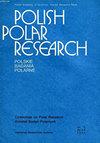Natural variability of major and trace elements in non-ornithogenic Gelisoils at Edmonson Point, northern Victoria Land, Antarctica
IF 0.8
4区 地球科学
Q4 ECOLOGY
引用次数: 5
Abstract
Antarctica is perceived as one of the most pristine environments on Earth, though increasing human activities and global climate change raise concerns about preserving the continent’s environmental quality. Limited in distribution, soils are particularly vulnerable to disturbances and pollution, yet lack of baseline studies limits our abilities to recognize and monitor adverse effects of environmental change. To improve the understanding of natural geochemical variability of soils, a survey was conducted in the fellfield environments of Edmonson Point (Victoria Land). Soil samples were analyzed for six major (Fe, Ca, Mg, Na, K and Ti) and 24 trace elements (As, Ba, Be, Bi, Cd, Co, Cr, Cs, Cu, Ga, Li, Mn, Mo, Ni, Pb, Rb, Sn, Sr, Tl, U, V, Y, Zn and Zr). Relationships among element concentrations in the samples and local bedrock were analyzed to identify their origin and similarities in geochemical cycles. Element concentrations in the soils were highly variable but generally within the lowest values reported elsewhere in Antarctica. Though values of Cd, Mn, Ni and Zn were relatively high, they are consistent with those in the local soil-forming rocks indicating an origin from natural sources rather than anthropogenic contamination. Chemical composition of soils vs. rocks pointed to alkali basalts as the lithogenic source of the soil matrix, but also indicated considerable alteration of elemental composition in the soil. Considering local environmental settings, the soil elemental content was likely affected by marinederived inputs and very active hydrological processes which enhanced leaching and removal of mobilized elements. Both of these processes may be of particular importance Jerzy Smykla et al. 20 within the context of global climate change as the predicted increases in temperature, water availability and length of the summer season would favor mineral weathering and increase geochemical mobility of elements.南极维多利亚地北部埃德蒙森角非鸟源性冰沙中主要和微量元素的自然变异
南极洲被认为是地球上最原始的环境之一,尽管越来越多的人类活动和全球气候变化引起了人们对保护该大陆环境质量的担忧。土壤分布有限,特别容易受到干扰和污染,但缺乏基线研究限制了我们认识和监测环境变化不利影响的能力。为了提高对土壤自然地球化学变异性的认识,对维多利亚地埃德蒙森角(Edmonson Point)的农田环境进行了调查。分析了6种主要元素(Fe、Ca、Mg、Na、K和Ti)和24种微量元素(As、Ba、Be、Bi、Cd、Co、Cr、Cs、Cu、Ga、Li、Mn、Mo、Ni、Pb、Rb、Sn、Sr、Tl、U、V、Y、Zn和Zr)。分析了样品中元素浓度与当地基岩的关系,确定了它们的来源和地球化学旋回的相似性。土壤中的元素浓度变化很大,但一般在南极洲其他地方报告的最低值之内。Cd、Mn、Ni、Zn含量较高,但与当地成土岩中Cd、Mn、Ni、Zn含量基本一致,表明其为自然污染而非人为污染。土壤与岩石的化学成分对比表明,碱性玄武岩是土壤基质的产岩源,但也表明土壤中元素组成发生了较大的变化。考虑到当地的环境条件,土壤元素含量可能受到海洋来源输入和非常活跃的水文过程的影响,这些水文过程促进了淋滤和移动元素的去除。在全球气候变化的背景下,这两个过程可能特别重要,因为预测的温度、水分供应和夏季长度的增加将有利于矿物风化和增加元素的地球化学流动性。
本文章由计算机程序翻译,如有差异,请以英文原文为准。
求助全文
约1分钟内获得全文
求助全文
来源期刊

Polish Polar Research
ECOLOGY-GEOSCIENCES, MULTIDISCIPLINARY
CiteScore
2.00
自引率
7.70%
发文量
0
审稿时长
>12 weeks
期刊介绍:
The quarterly Polish Polar Research edited by the Committee on Polar Research of the Polish Academy of Sciences is an international journal publishing original research articles presenting the results of studies carried out in polar regions.
All papers are peer-reviewed and published in English.
The Editorial Advisory Board includes renowned scientist from Poland and from abroad.
 求助内容:
求助内容: 应助结果提醒方式:
应助结果提醒方式:


